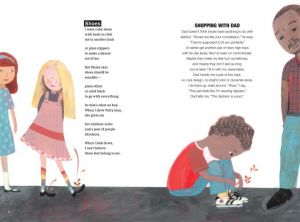Can I Touch Your Hair?: Poems of Race, Mistakes, and Friendship by Charles Waters
Two schoolmates—serving as stand-ins for poets Latham and Waters—reluctantly pair up on a poetry-writing project and reflect on their existences, relationships, and the role race plays in their lives, in more than 30 candid, thought-provoking poems. [1]
Summary
Two poets, one white and one black, explore race and childhood in this must-have collection tailored to provoke thought and conversation. How can Irene and Charles work as a team on their fifth grade poetry project? They have no clue each other and they're not sure they like to. Irene Latham, who is white, and Charles Waters, who is black, use this fictional setup to delve into different experiences of race in a relatable way, exploring such themes as hair, hobbies, and family dinners. Along by artwork from acclaimed illustrators Sean Qualls and Selina Alko (of The Case for Loving: The Fight for Interracial Marriage), this remarkable collaboration invites readers of all ages to join the dialogue by putting their own words to their experiences. [2]
Pros
When students Irene and Charles end up as a team work for a poem-writing project, they slowly and bravely starts to create how the issue of race affects their lives. Irene’s white opinion and Charles’s black perspective are inherent even when they begin by writing about a subject seemingly devoid of racial context—shoes. Their back to back topic, hair, opens a dialogue that includes the emotional effects of race-based conflicts at school. As the children move on to poems affecting their friends and families, readers sense a developing trust and warmth that leads to a beautiful jointly-written poem at the end. [3]
Can I Touch Your Hair? is not only a great story, it is a high jumping-off point for talking with children about race and privilege, commonalities and differences. it can be used for middle school racial identity lessons and this can also encourage teachers to use it as a read aloud in their classrooms. One of the best ways to reduce racial bias is to gather with or get to know people who are different from ourselves. One strong way we can take this is through literature. This book can be an insightful part of that journey. [4]
References
- ↑ https://www.publishersweekly.com/978-1-5124-0442-5#:~:text=Poems%20of%20Race%2C%20Mistakes%2C%20and%20Friendship,-Irene%20Latham%20and&text=Two%20classmates%E2%80%94serving%20as%20stand,candid%2C%20thought%2Dprovoking%20poems.
- ↑ https://www.amazon.com/Can-Touch-Your-Hair-Friendship/dp/151240442X
- ↑ https://www.goodreads.com/en/book/show/34007179
- ↑ https://www.friendsjournal.org/book/can-i-touch-your-hair-poems-of-race-mistakes-and-friendship/

